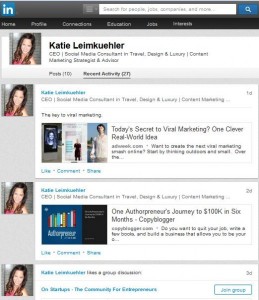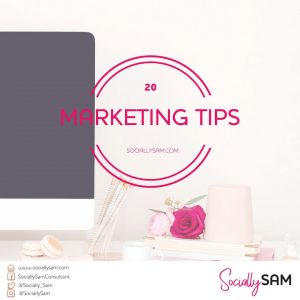Launching a marketing campaign without knowing your audience is like shooting into the dark. You have no clear target and no concept of what success actually looks like.
This is why your target market is so important to your business.
What Is a Target Market?
The term is pretty straightforward. Your target market is a description of who your ideal customers are. When you’re identifying your target market, you need to look at all aspects of who fits into that market, including demographics and psychographics.
If you’re a marketer, then your market isn’t just your market. It’s your audience. That means you have an obligation to know what your audience wants and where they’re going for the kind of content that’s most meaningful for them.
This remains true for every business in every industry. B2B. B2C. You name it, you need to lay the foundation of your marketing by first understanding your target market.
The Benefits of Knowing Your Target Market
The advantages of understanding your target market and knowing where your audience hangs out online are numerous.
- You study who real people in your market are by looking at their online presence within communities.
- You find trends and patterns in the content they consume, which informs your content strategy.
- You see how they describe their pain points and learn what kind of language and expressions they respond to.
- You gain more information on what they actually don’t like or care about.
- You see how they assess products or services that relate to your business.
- You learn what your industry is doing when presenting value propositions to them.
- You identify which platforms may be able to provide you with beneficial partnerships.
- You determine what websites might be useful in display advertising or strategic partnerships, like guest blogging.
Wow, that’s a lot of little gains that can add up to big results. But how do you figure out where your target audience is?
How to Define and Find Your Target Market
While this process takes a little detective work, it will pay off handsomely in the end. The first part of this process involves defining who your target market consists of, and the second part requires actually finding them in real life.
1. List What Tools and Information You Have Upfront.
The first step requires an honest look at what resources you currently have on hand. In other words, what are you working with?
Some things to list include:
- Existing buyer personas
- Social monitoring tools
- SEO tools
- Customer journey maps
- A documented content strategy
Finding your target market calls for deep dives into customer data. If you have data, which you usually collect and manage in your CRM platform, then you can get started with creating or updating your buyer personas so they truly reflect your ideal customer.
If you don’t have customer data, you can start by making assumptions and brainstorming what it’s like to be your ideal customer. But to really dive deep and gather the information you need, start conducting audience research.
6 Ways to Conduct Audience Research
Your main goals of researching your audience are to:
- Identify their top pain points and goals.
- Find keywords they’re using to search for solutions.
- Understand their buying behaviors.
- Gain insights on how they find and use educational content.
Here are six tips for getting to know your audience:
- Conduct surveys of your existing customers and prospects to gather pertinent information, like what their buying patterns are and how they found you.
- Develop a social listening strategy using the right tools to find topics they’re talking about and where they’re having those discussions.
- Post questions in relevant social media groups and communities where your ideal customers hang out.
- Create a CRM strategy that gets all your teams on the same page and ensures all customer data is accurate, up to date, and detailed enough to inform your marketing efforts.
- Publish interactive content on your site like fun quizzes that allow you to gather data from your visitors.
- Conduct interviews with customers and prospects about what they like about your brand and how they chose your product or service.
These audience research tips are integrated throughout the following steps. Before moving onto the next steps, you should have completed buyer personas for each segment of your target market. This might call for several personas, depending on your business.
For example, if you’re an educational tech company that offers online courses in leadership development and in career planning, your target market might include buyer personas who are seasoned veterans in leadership roles and other personas who are just getting started in their career, like recent graduates or college students.
Simply put, have documented buyer personas at the ready before continuing. As you will see, understanding your target market requires consistent efforts in gathering additional data and staying on top of areas where they’re spending time.
2. Make Sure Your Data Analytics Software Is Working.
As mentioned before, inferences, intuition, and assumptions about your audience all have their place in understanding your market, but data is the undisputed king. Your analytics suite should be keeping track of both links to your website and sources of incoming traffic.
Not only will you be able to act quickly if you find your site linked by a great industry source, but you’ll also see what visitors read just before they saw you.
Audit your current analysis process to make sure all your tools are working together.
For example, if your website is built on HubSpot, you should double check that you have access to the right reports in your reporting dashboard, ensure your CRM is capturing all the data you need, and set up other reporting tools like Google Analytics or heatmapping software.
3. Execute Your Social Listening Strategy.
A buyer persona can be a helpful, interesting tool – but the rubber meets the road when you start talking about real people. Get used to watching your social media accounts to pinpoint the websites shared by the most influential users who also follow your brand’s updates.
This is why, as mentioned above, a social listening strategy is essential for fully defining your target market. There are so many awesome tools, like BuzzSumo, that deliver insightful information in no time.
Another way you could work this is by picking someone (whether they follow you or not) who meets your buyer persona criteria in every respect. Do some research on some of the top social sites like Facebook and Twitter to get a better idea of how your buyer personas behave online.
Keep a close eye not only on what sources they read and discuss, but also what content they cheer for and make use of.
This lets you take the buyer persona (which can be a little bit abstract) and bring it down to earth in a meaningful, relatable way. You can also experiment with approaches to learning about and meeting these “core users” by sending content to them or to influencers they respect.
4. Use Progressive Profiling for Traffic Attribution.
Most people start their journey using a generic online search. They also tend to gravitate toward a core set of publications and online platforms to find their news and research.
They know what these are. You just have to ask them, which you can accomplish through progressive profiling.
Your marketing automation platform helps with this. You simply build shorter forms that gather the bare essentials, then when that lead comes back for another conversion, the next form they see asks for some new information.
This helps in one big way: You aren’t turning them away with super long forms that require 12 fields to be completed.
Instead, as you establish trust, they come back for more gated content, and they give you a little more information about themselves with each conversion.
When you first start qualifying a lead, it’s important to ask him or her only the questions that are really essential. However, you can experiment with putting “How did you find us?” into your contact or email subscription form to get leads on the websites prospects use.
Even more effective, however, is using post-sales surveys for already-existing customers.
5. Get Answers from New, Eager Customers.
Within a week to two weeks of the sale, your new customers are about as happy with you as they’ll ever be. They’re also more likely to answer questions you might have.
Naturally, that enthusiasm will lose steam over time, so it’s important to get on it immediately. Depending on the situation, an email survey or a one-to-one conversation with a sales rep might be the best way to get details on which sites your customers consider most trustworthy.
Weigh your options based on any customer service or technical issues the new customer has been having and whether it would be a good idea to have a wide-ranging chat with them while gathering the information you’re interested in.
6. Check Out General Forums and Websites.
General forums like those on Reddit might seem like a tough place to get solid intelligence on business matters, but it depends how closely you look.
People are more likely to relax and be themselves on these forums, and that includes sharing info about their favorite sites.
You can also look at popular thought leadership sites like Medium and LinkedIn. Not only will people share their lists of “best sites” in your space, they’ll also be keen to answer and ask questions – so, you’ll be able to see what problems people in your industry are struggling with right now.
That gives you a massive head start when it comes time to create and execute a content marketing strategy.
How to Connect With Your Target Market Through Content
As you continue learning more about your audience, you’re able to document a strategy that delivers the right content to the right people at the right time.
Identify What Sets You Apart.
You want a clear idea of how your products and services stand out in your target market. This requires taking an honest look at how you stack up against your competitors.
Answer these questions:
- What is the one most notable offering you provide for your customers?
- How do your offerings address your buyer persona’s primary pain points?
- What do your competitors offer to help with these pain points?
- How are your offerings unique and better than your competitors’ offerings?
If you have several personas, you want to answer these questions for each one of them because you’re likely offering different products or services to each segment.
Audit Your Current Content Assets.
Once you know your brand’s unique value, start assessing the content you already offer that supports your marketing goals.
A comprehensive content audit should help you find top performers, identify opportunities for optimizing current content assets, understand content gaps, and steer the general direction of your content strategy.
Conduct Keyword Research.
Using what you know about your buyer personas, you can list out topics that they’re likely researching. From that list, use SEO tools to dive deep on common keywords and search queries.
Build a list of relevant keywords you want to target with your content strategy.
Create a Customer Journey Map.
When you have buyer personas and insights from your audience research, you’re ready to develop customer journey maps for each persona.
These walk you through their entire customer experience, from the initial awareness stage of the buyer’s journey to after they make a purchase decision.
A map should shed some light on each touchpoint they experience and inform how you can deliver relevant, engaging content to guide them through their journey to ultimately purchase from you.
Start Mapping New Content Ideas.
Content mapping involves aligning your content with each buyer persona and their lifecycle stage. When you create a content map, you’re ensuring that you’re acting as a trustworthy, credible resource for your audience throughout their journey.
If you’re showing up and helping in impactful ways at the right time, you’re bound to drive leads and fill your sales pipeline with qualified prospects.
______
Remember, you should commit to continuously revisiting this and updating it as your industry and your business evolve over time. That’s how you stay relevant and establish yourself as a trusted resource for the long term.
Business & Finance Articles on Business 2 Community
(59)






